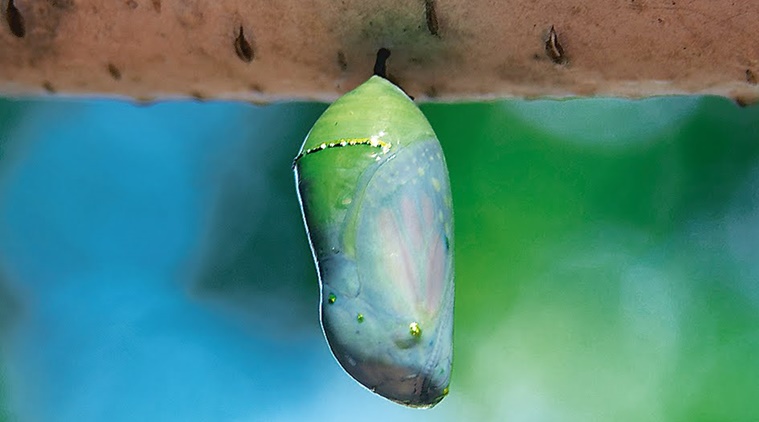 It’s a wonder: A butterfly chrysalis. (Source: Wikimedia Commons)
It’s a wonder: A butterfly chrysalis. (Source: Wikimedia Commons)
We really have gotten ahead of ourselves, haven’t we? We pride ourselves on being at the very top of the food chain, of being able to “conquer” and “control” Mother Nature according to our whims and fancies. In every way, our technology comes out tops. Ah, but does it? Here’s a set of gentle reminders that will show that in most vital aspects of life and living, Mother Nature is way ahead of us and we’re not going to catch up in a hurry (if ever).
Take that process which sustains nearly all life on the planet: photosynthesis. Silently and efficiently, green leaves use solar energy to make food (sugars) out of thin air and water as it were. Not only that, the “waste” gas that is emitted is what permits all life on earth: oxygen. We may now understand the intricate chemistry involved — but we’re not going to be producing green leaves ourselves in the foreseeable future!
We now know exactly how a butterfly chrysalis turns into a butterfly with the ingenious help provided by miracle enzymes. Most of the caterpillar cells (making up its muscles, for example) are broken down into their protein constituents, while cells of the butterfly parts — the wings, proboscis, etc., which so far have been kept in a state of arrested development by another miracle enzyme — get activated as this enzyme level drops. The butterfly cells live off the erstwhile caterpillar cells and grow inside the chrysalis until ready to emerge. Let’s see us do something like that!
Then, there’s the absolutely astounding process of evolution. Sure, it’s taken billions of years but it is astounding that all forms of life had a common ancestor. Every living creature that evolved did so to survive its particular environment and pass on its genes, but in doing so, it found its niche in the world, so that in the end it all fitted, like a giant jigsaw puzzle. Talk about Mother Nature taking a macro view of life while taking care of every micro detail too! Every living thing is tuned pitch-perfect: carnivorous predators are able to kill and eat just enough herbivores so that the latter don’t clean up all plant life. If all plant life dies, well, herbivores will die of starvation — and then so will the carnivores. All that will be left are lifeless wastelands.
We did manage to study how birds fly and used the same principles of aerodynamics while designing aircraft. But at what cost? Think of the bundobust involved in getting a single flight off the ground. A million checks and counter-checks, thousands of gallons of aviation fuel, the emission of huge quantities of greenhouse gases — and the fact that you need to be at the airport at least three hours before your flight! A bird on a wire just raises its tail, craps (to lighten its load), spreads its wings and is up and away. Banks of computers guide the jet to its destination — a bird has all that navigation equipment tucked away in its bird brain and will fly across continents if on annual migratory trips.
Again, it’s only recently that we’ve unravelled the mystery around insect flight — which uses a completely different approach: basically an insect generates little tornadoes around its very flexible wings to attain lift. We’re now frantically trying to emulate that. Every living creature has features which we would love to copy by bio-engineering. We’ve accepted, perhaps, that we can never create artificial mechanisms as wondrous, so are fiddling with genes to see if they can be borrowed to do the job.
Our ultimate boast is that we can destroy the planet in a matter of minutes. So can Mother Nature: there’s a super-volcano sitting beneath Yellowstone National Park, which is a time bomb of sorts. Not to mention the ring of fire around the Indonesian islands. We all saw what the tsunami did back in 2004. But, unlike us, Mother Nature does not seem as intent on destroying the planet as she is on sustaining it.
Her absolute number one miracle is, of course, that of creating self-sustaining life. What was the magic formula that made an inanimate object, animate and alive? And then evolve into a million incredible forms of life? For thousands of years, we’ve polluted her air, water and soil, flattened her forests and behaved like power-crazed lunatics. Now she’s showing us what she can do — with an infinitesimal, invisible enemy that has brought life as we know it to a grinding halt. Oh yes, we still dare to boast that sooner or later we’ll get a handle on this — but, well, there’s sure to be another more insidious and dangerous little bug waiting in the wings for its cue.
In effect, Mother Nature has put us across her knees and is giving us a resounding spanking. It really is time to say sorry and begin to mend our ways.